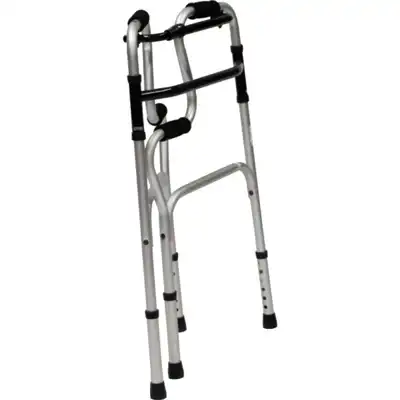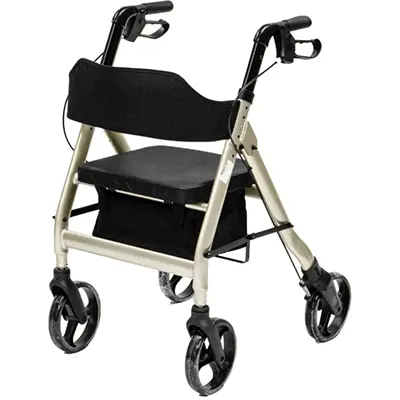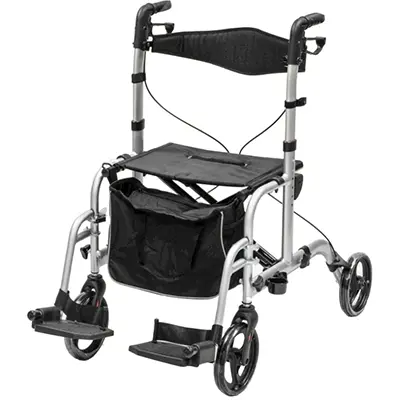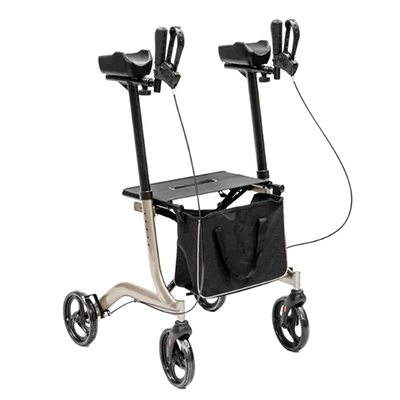Guide to buying a walker or rollator
Find out about the main types of walkers and rollators and their different features to help you decide which type is right for you.
Walkers
A walker is a four-legged metal frame used to support you while you walk. They’re ideal for people who can still walk and don’t need a wheelchair but could use a little extra help. It allows the user to lean on the frame for balance and rest.
Walkers are usually made from aluminium because it’s a strong metal but also relatively light. It can support a significant amount of weight but is also easy to move around. Walkers also have rubber or foam grips to make them easy to lean on.
Types of walkers
While walkers all essentially do the same thing, some are designed for specific needs. It’s important to be aware of these differences to help you choose the right walker for you.
These are the most common types of walkers and their features.
Folding walker
A folding walking frame is a walker that can fold up to a compact size. In fact, most modern walkers can easily be folded, so you’ll find this feature on almost any walking frame you’re looking at. This allows the walker to be stored or transported easily.

Height adjustable walker
The ability to adjust the height of the walker is essential to making sure it fits you. As with the folding mechanism, almost all modern walkers will be height adjustable.
Walker with front wheels
Some walkers have two front wheels. This is to make it easier to move the walker over difficult terrain. Most of them have a five-inch wheel, which is a good size to ensure they glide smoothly over the ground.

Bariatric walkers
A bariatric walker is designed to support larger people. Standard walking frames are designed to support people with weight of around 100kg, but if you’re heavier you need a stronger frame to support you. Bariatric walkers can support a person who weighs up to 225kg.
Rollators
A rollator is a walker with wheels and other features. The frame on a rollator, like walkers, is usually aluminium. Rollators are more popular than walkers because their wheels make them easy to push around. They’re also more versatile, you can use them as a seat if you get tired. However, they can’t support as much weight as a walking frame because the wheels make them less stable.
Standard rollator features
Wheels
Rollators have three or four wheels. The wheels are usually five to eight inches in diameter. Essentially, the larger the wheel, the easier it is to push around. This is especially true if the ground is rough. If you think you’ll be pushing your rollator over uneven terrain, get one with larger wheels.
Seats
Most rollators have a seat. Often the seat is padded, offering a comfortable place to sit if you need a rest. However, you can get unpadded ones if you prefer. Padded seats offer more comfort, but unpadded ones are easier to clean.
Brakes
There are two main types of brakes on rollators: loop brakes and push-down brakes.
Loop brakes are the most common type of brake. They’re like bicycle brakes, where you squeeze a lever at the handle which activates the brakes via cable.
Push-down brakes are weight activated, so the user can just lean on the rollator to engage the brakes. This is designed for people with impaired memory or reduced hand strength.
Storage
Most rollators come with a storage compartment. Usually this is a basket or bag under the seat. Sometimes the basket is attached to the front of the rollator.
Types of rollators
While almost all rollators have the main features mentioned above, there are different types of rollators designed for specific needs. These are the main types of rollators and their features.
Three-wheeled rollator
Three-wheeled rollators have two wheels at the back and one at the front. They’re highly manoeuverable and are very useful for indoor use where there can be a lot of tight corners. However, they’re less stable than four wheels rollators.

Four-wheeled rollator
Four-wheeled rollators are the most common type of rollator. They’re easy to push and have plenty of stability. Because the weight is distributed over a larger surface area they’re smoother to push.

Bariatric rollator
Just like the bariatric walking frame, a bariatric rollator is designed for larger people. They’re built stronger and can support a heavier weight. They usually have larger wheels to provide more stability while riding over soft ground.
Lightweight/indoor rollator
These rollators are very light and are designed to be used indoors. Because of their small wheels they aren’t suited to riding over rough or uneven terrain. They also usually don’t have a seat.

Rollator and wheelchair combo
Some rollators can also be used as a wheelchair. The wheels have a much longer base, and footrests so someone can sit on it and be pushed. This is a highly versatile and practical option for people who need the option of using it as a walker, but also as a wheelchair when needed.

Gutter walker
A gutter walker is a rollator with arm rests, so it can take more of the user's weight. You can put your forearm in the rests provided and grip on to the handle. They’re designed for people who can't put much weight on their hands, for example, people with arthritis.

Knee walker
A knee walker is a rollator designed for someone who needs to rest one leg only. The leg is propped up on the walker while the other leg propels it, like a scooter. Knee walkers can come in three or four-wheeled versions.

Deciding which option is right for you
If you have limited balance and need something to support a lot of your weight, a walking frame might be best for you. If you can bear more of your weight but need a little extra support, and you want features like a seat and storage compartments, you might prefer a rollator.
This guide gives you an overview of the different types of walkers and rollators, but seek professional advice before you buy anything. The best way to decide whether you need a walking frame or a rollator is to go into your local Disability Information Centre and try some out. Talk to the staff and experiment using some of the different options. This will give you a good idea of what works for you.
Find your nearest Disability Information Centre.
